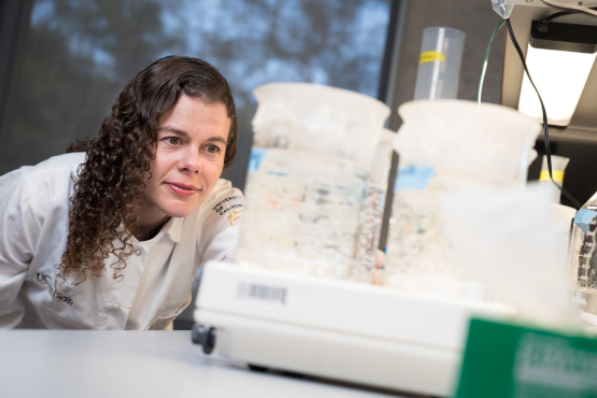Biomaterials that can promote tissue repair and regeneration on their own

San Diego, Calif., Jan. 24, 2019 -- “Biomaterials that can promote tissue repair and regeneration on their own without the need for delivering cells or other therapeutics have emerged as a potentially powerful paradigm for regenerative medicine.”
That’s one of the key statements in a perspective piece written by Karen L. Christman, a professor of bioengineering at the University of California San Diego in the Jan. 24 issue of the journal Science.
Christman’s research group at the Jacobs School of Engineering at UC San Diego focuses on developing innovative biomaterials for tissue engineering and regenerative medicine applications. The lab has a strong translational focus with the main goal of developing minimally invasive therapies for cardiovascular disease. Projects are highly interdisciplinary and involve collaborations with basic scientists, engineers and physicians.
“Biomaterial scaffolds have several advantages compared to cell-based regenerative medicine, including reduced costs and fewer translational barriers,” she writes.
For example, “a biomaterial scaffold, if appropriately designed, can create a new microenvironment in diseased tissue that mimics the original healthy extra-cellular matrix and/or provides cues that influence the behavior of infiltrating cells to promote tissue repair or regeneration.”
In addition, “biomaterials that are synthesized or sourced directly from animals or human can have considerably reduced costs.” And “although biomaterials that require cell culture in their manufacturing may not avoid high costs, they still obviate concerns regarding the use of a living product and may be amenable to terminal sterilization, which reduces safety concerns.”
Christman is a cofounder of Ventrix, a startup that is bringing to the clinic some of the technologies developed in her research group. Her work is at the forefront of the field, as reflected by studies she coauthored cited in the piece.
In 2013, Christman and colleagues at UC San Diego and Ventrix demonstrated in a study in pigs that a novel injectable hydrogel can repair damage from heart attacks; help the heart grow new tissue and blood vessels; and get the heart functioning closer to how a healthy heart should. The results of the study were published in Science Translational Medicine. The gel is injected through a catheter without requiring surgery or general anesthesia -- a less invasive procedure for patients.
Ventrix licensed the technology from UC San Diego and has completed a first-in-man trial in heart failure patients who previously suffered a heart attack. The Phase 1 study results with VentriGel, a cardiac extracellular matrix hydrogel deliverable through a catheter, were very encouraging and the company is gearing up for a Phase 2 trial for heart failure patients.
In 2016, Christman and colleagues reported on a potential new therapy for critical limb ischemia, a condition that causes extremely poor circulation in the limbs and leads to an estimated 230,000 amputations every year in North America and Europe. The new therapy could prevent or limit amputations for a condition that affects more than 27 million people and is a manifestation of advanced peripheral arterial disease.
The therapy consists of injecting in the affected area a gel derived from the natural scaffolding, or extracellular matrix, in skeletal muscle tissue. The team tested the procedure in a rat model of the disease and found that it promotes muscle remodeling and improves blood flow. They published their findings in the Journal of the American College of Cardiology: Basic to Translational Science.
In 2017, the team was awarded nearly $2.8 million by the governing Board of the California Institute for Regenerative Medicine to further their work.
Christman also writes in the Science piece that the biomaterials research has many other questions to explore.
“A critical mode of action by which biomaterials can promote tissue repair is through influencing the immune response. Although further work is needed, studies have suggested that biomaterials can play a major role in influencing the polarization of both macrophages and T cells,” she writes.
“These studies highlight the importance of studying biomaterial scaffolds in the context of a fully functioning immune system, as well as examining biocompatibility and the repair response in the tissue of interest.”
She concludes:
“Although more mechanistic studies are needed to better understand how biomaterials scaffolds can recreate the microenvironment and influence the immune system and tissue regeneration, they are already poised to have immediate patient impact and represent an alternative paradigm for regenerative medicine.”
